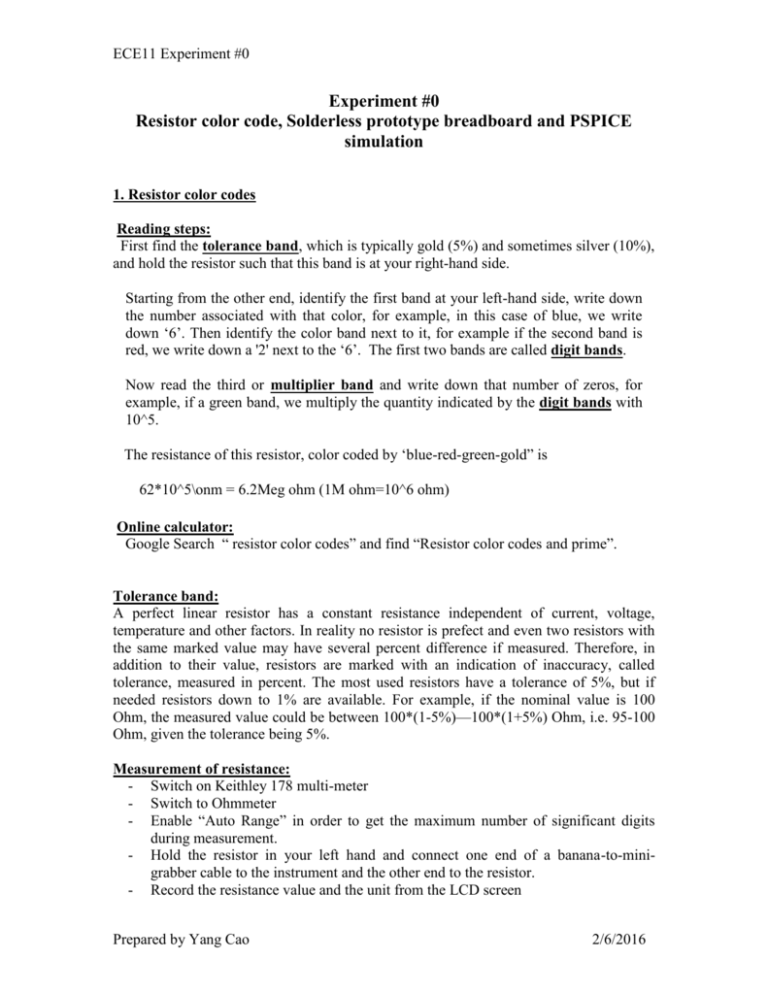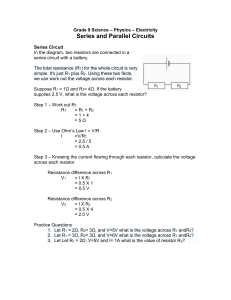ECE 11 Experiment #0
advertisement

ECE11 Experiment #0 Experiment #0 Resistor color code, Solderless prototype breadboard and PSPICE simulation 1. Resistor color codes Reading steps: First find the tolerance band, which is typically gold (5%) and sometimes silver (10%), and hold the resistor such that this band is at your right-hand side. Starting from the other end, identify the first band at your left-hand side, write down the number associated with that color, for example, in this case of blue, we write down ‘6’. Then identify the color band next to it, for example if the second band is red, we write down a '2' next to the ‘6’. The first two bands are called digit bands. Now read the third or multiplier band and write down that number of zeros, for example, if a green band, we multiply the quantity indicated by the digit bands with 10^5. The resistance of this resistor, color coded by ‘blue-red-green-gold” is 62*10^5\onm = 6.2Meg ohm (1M ohm=10^6 ohm) Online calculator: Google Search “ resistor color codes” and find “Resistor color codes and prime”. Tolerance band: A perfect linear resistor has a constant resistance independent of current, voltage, temperature and other factors. In reality no resistor is prefect and even two resistors with the same marked value may have several percent difference if measured. Therefore, in addition to their value, resistors are marked with an indication of inaccuracy, called tolerance, measured in percent. The most used resistors have a tolerance of 5%, but if needed resistors down to 1% are available. For example, if the nominal value is 100 Ohm, the measured value could be between 100*(1-5%)—100*(1+5%) Ohm, i.e. 95-100 Ohm, given the tolerance being 5%. Measurement of resistance: - Switch on Keithley 178 multi-meter - Switch to Ohmmeter - Enable “Auto Range” in order to get the maximum number of significant digits during measurement. - Hold the resistor in your left hand and connect one end of a banana-to-minigrabber cable to the instrument and the other end to the resistor. - Record the resistance value and the unit from the LCD screen Prepared by Yang Cao 2/6/2016 ECE11 Experiment #0 Calculate Percentage Error: For a given resistor, we measure the difference between its nominal resistance and measured resistance in the percentage, which is called percentage error, given by | NV MV | PE *100% , NV where PE represents for percentage error, NV for nominated value and MV for measured value. Exercise 1: a). Read the color codes of 3 resistors and identify their resistances. Resistor Color codes Nominated value Measured Value Percentage Error 1 2 3 b) Do all of the resistors fall within the tolerance indicated by the color code? 2. Solderless prototype breadboard We use solderless breadboard to connect components and build circuits in ECE 11 Class. In a circuit, the legs of components are placed in the holes (the sockets). The holes are made so that they will hold the component in place. Each hole is connected to one of the metal strips running underneath the board. There are wire strips connecting the holes on the top of the board. Each wire forms a node. A node is a point in a circuit where two components are connected. Putting their legs in a common node forms connections between different components. On the breadboard, a node is the row of holes that are connected by the strip of metal underneath. Prepared by Yang Cao 2/6/2016 ECE11 Experiment #0 The long top and bottom row of holes are usually used for power supply connections. The rest of the circuit is built by placing components and connecting them together with jumper wires. Then when a path is formed by wires and components from the positive supply node to the negative supply node, we can turn on the power and current flows through the path and the circuit comes alive. For chips with many legs (ICs), place them in the middle of the board so that half of the legs are on one side of the middle line and half are on the other side. Exercise 2: a). Give a Use the Ohms function of the Keithley Model 175 to verify the connection of the breadboard. [Hint] If the resistance between two nodes in the board is 0 Ohms, that means that two nodes is connected. If the resistance is too high (OverLimit), two nodes is not connected. b). Schematically illustrate how to connect a mixed series and parallel circuit on the breadboard. 3.Units of some physical parameters Physical Parameters Primary Unit Secondary Units Current (I) Voltage (V) Power (P) Resistance(R) Ampere (A) Volt (V) Watt (W) Ohm () mA , uA mV mW K, M Relationship between primary and secondary units Exercise 3: a). Finish the last column of the above table. b). Draw a series dc circuit containing 2 resistors, with resistance of 4.7M and 9.1M respectively. A 5v dc battery is used as voltage source. Find the current, voltage drop and power for each resistor. Pay attention to units used. 4. Cadence PSPICE simulations -Demonstration of simulating a simple dc series circuit (Circuit 4-1a) and introduce two ways to find voltage drops, i.e., ohm’s law and node voltage difference. -Draw Circuit 4-1b by changing the location of GND in Circuit 4-1a. Find node voltages and voltage drops, compare results with those from Circuit 4-1a, and explain the role of reference node GND in a circuit. Prepared by Yang Cao 2/6/2016 ECE11 Experiment #0 Exercise 4: a). Through simulation, find the current at each resistor of Circuit 4-1a. Calculate voltage drops using ohm’s law as well as node voltage difference. Form a table to show results. b). Through simulation, find the current at each resistor of Circuit 4-1b. Calculate voltage drops using ohm’s law as well as node voltage difference. Form a table to show results. How does the position of GND node affect your simulations result? How does the location of ground affect the currents, node voltages or voltages drop? c). Through simulation, find the current at each resistor of Circuit 4-2. Calculate voltage drops using ohm’s law as well as node voltage difference. Form a table to show results. Your report is expected to give solutions to all 4 excises. Try to follow the lab format posted on ECE 11 class website to write your first lab report. Please remember to attach your simulations of each circuit when you submit your report. Prepared by Yang Cao 2/6/2016









